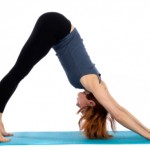What is Ashtanga Yoga, and what does it have to do with Patanjali’s Eight Limbed Path? To some people, Ashtanga is the physical origin of vinyasa flow, but to others, it is the physical limb of Raja Yoga. There is truth to both sides of the story, but I will briefly try to answer the question: “What is Ashtanga?” Ashtanga Yoga, the ancient style on which Power Yoga is based, stresses synchronization of the breath with progressive postures to build internal heat and cleanse the body. Introduced by Sri K. Pattabhi Jois to contemporary society, Ashtanga’s lineage dates back to a manuscript known as “Yoga Korunta,” meaning “book about Yoga.”
The Eight Limbs of Ashtanga Yoga
The literal meaning of “Ashtanga” is “eight-limbed Yoga,” as described in Patanjali’s “Yoga Sutras.” The eight branches embrace the following disciplines:
1. Yama (morality)
2. Niyama (self-reflection and purification)
3. Asana (physical exercise or poses)
4. Pranayama (controlled breathing)
5. Pratyahara (control of the senses)
6. Dharana (concentration or focus)
7. Dhyana (meditation)
8. Samadhi (union with the divine)
The first four limbs are considered external cleansing processes, while the latter four are internal.
The Six Sequences of Ashtanga
Authentic Ashtanga consists of six series, each always performed in the exact same order. Each set grows increasingly more difficult. As a result, some instructors change the flow to make the system more practical for 21st-century students who cannot commit to intense daily practices.
The Two Subgroups of Ashtanga
Primary Ashtanga
The first two series of postures make up the primary practice. The first sequence mostly involves forward bends, while the second concentrates on backbends, adding inversions and arm balances.
Advanced Ashtanga
Each of the remaining four series grows increasingly more difficult. Like other Yogic disciplines, Ashtanga has changed, making specific names and sequences harder to define.
The Purpose of Ashtanga
Ashtanga Yoga raises the body’s core temperature through the precise execution of specific postures in predetermined sequences. A vigorous practice best suited to fit individuals, Ashtanga requires steady, consistent practice for visible results. Some teachers recommend four to seven hours per week. Those who pursue the Ashtanga path can expect to cleanse their bodies, tone their muscles, enjoy better circulation, process emotional baggage, and sharpen their mental faculties. Longer lives may compensate for their commitment.
Developing Strength and Awareness
There are many reasons why Ashtanga Yoga is often recommended for those who are seeking to improve their physical and mental health. One of the main attractions of this form of yoga is that it strengthens and tones the body while providing a healthy outlet for stress relief. However, as with any physical activity, there is always some risk of injury associated with practicing Ashtanga Yoga. While the risks are relatively low, it is still important to be aware of them so that you can take steps to minimize your chance of injury.
About Repetitive Motion
One potential risk to keep in mind is that of repetitive motion injuries. These can occur when you overuse a particular muscle group or joint through repetitive motions. For example, if you practice yoga poses that require you to raise your arms above your head repeatedly, you may be at risk for developing shoulder pain or other issues. This is not to say that you should avoid all poses that involve raising your arms overhead. Rather, it is important to be aware of the possibility of repetitive motion injuries and take steps to avoid them.
Home Practice
You may want to focus on other poses that work in different muscle groups in your home practice when you know you will be practicing poses that involve raising your arms overhead. Pay attention to shoulder joint wear during some of the transitions. By being aware of the potential risks associated with Ashtanga Yoga and avoiding them, you can help ensure that you enjoy all the benefits this wonderful practice offers without putting your joint health at risk.
© Copyright – Aura Wellness Center – Publications Division
Please visit the following link to see our online Yoga teacher training courses.
https://aurawellnesscenter.com/store/
Are you interested in Meditation Teacher Training?
Click here to see our online Yoga Nidra teacher training course.
Are you an experienced teacher looking for YACEP credits or continuing education?
Subscribe to Our Newsletter for Special Discounts and New Products
Related Resources
52 Essential Principles of Yoga Philosophy to Deepen your Practice
by Rina Jakubowicz.
A Relaxing Way to De-stress, Re-energize, and Find Balance
by: Gail Boorstein Grossman.
YOGA: THE PATH TO HOLISTIC HEALTH
by B.K.S. Iyengar
TEACHING YOGA: Essential Foundations and Techniques
See our selection of affordable yoga teacher certification courses.


Amazing!! Love the infos here. I just started yoga and wish I could be flexible as I wanted.
Ashtanga Yoga is the power yoga based ancient style yoga which stresses synchronization of the breath with a series of progressive postures in order to build internal heat and cleanse the body. Thanks for posting this nice article.
Those who pursue the Ashtanga path can expect to cleanse their bodies, tone their muscles, enjoy better circulation, process emotional baggage, and sharpen their mental faculties. Thanks for sharing this informative article.